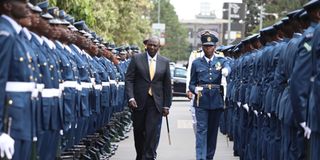The challenges and priorities in President Ruto’s full in tray

President William Ruto inspects his first guard of honour at Parliament Buildings since being elected head of state. What seems to dominate public discussions are challenges that face many citizens and whether President William Ruto will resolve them.
What you need to know:
- The 2022 election disrupted the way we all see Kenya; it was an election in which the poor were clearly telling the rich that they will not be comfortable if the poor are not comfortable.
- But the 2022 election showed that the real contours of Kenyan society are the economic and income inequalities.
- But the way the ordinary voters expressed themselves everywhere is a sign that they are tired of policies that address the needs of the rich only.
Kenya’s August 2022 election mood is over. Unlike in 2017 when signs of fresh campaigns started immediately after the announcement of the 2017 presidential poll results, the last elections appear to be concluded.
What seems to dominate public discussions are challenges that face many citizens and whether President William Ruto will resolve them.
There is no doubt that the 2022 election was a close one. There is no doubt that it was also a ‘class election’.
We may want to deny it, but the election pitted the ordinary citizens against the middle class, the salaried, the rich and generally the elite, who are perceived to live in the comfort that their money can buy.
Old money was pitted against new money. The rural was up against the urban. It was about deep income inequalities we have failed to discuss in the last 59 years of independence.
It was an election that disrupted the way we all see Kenya; it was an election in which the poor were clearly telling the rich that they will not be comfortable if the poor are not comfortable.
Language of inequalities
To some, this language of inequalities and poverty gaps was evidently open in the 1960s and early 1970s but covered up by retrogressive development policies and actual political repression.
But the 2022 election showed that the real contours of Kenyan society are the economic and income inequalities.
But the way the ordinary voters expressed themselves everywhere is a sign that they are tired of policies that address the needs of the rich only.
I recall an instance in a research focus group discussion where participants were mad at how roads are tarmacked every other time but there is no money to pave walkways.
Those who walk to work because they cannot afford bus fare have to make do with muddy paths. To them, the roads are what they are because the elite and policy bureaucrats forget that there are ordinary people who need better walkways.
I am very confident that the elite voted in a different manner from these ordinary voters.
With elections over, the challenge of making and implementing policies that run along these contours begins.
There is no doubt that ‘class divisions’ are a nightmare for leaders everywhere. Ordinary citizens always want their challenges addressed with urgency. And everything must be done now.
The middle class has ‘exit’ options: if the government does not provide, they buy. For instance, if the county government does not provide clean water, they drill boreholes.
But they drill for self-use – not to share. If insecurity is on the increase, they hire security firms.
Unfortunately, they treat all public goods as commodities for purchase because they have the money.
Unknown to them, the poor do not live far from them. If there were a crisis, Muthaiga is a walking distance from Mathare. Lavington is next door to Kawangware. Kibera is in Lang’ata and neighbours Karen.
On the whole, the 2022 election was a ringtone of trouble and a pointer that failure to put in place policies that address the challenges of development for all is the bane of our society.
It is one pointer that failure to address issues that affect ordinary citizens will come to haunt the elite, who live in the comfort of what the money can buy. What then should be the priorities of President Ruto’s government?
Throughout the year and before the start of the 2022 elections, public opinion polls repeatedly pointed at a high cost of living, unemployment and poverty as the many challenges facing Kenyans.
Slightly below these concerns were issues of poor health services, and increasing cost of, ironically, ‘free basic’ education.
Some people were concerned about the extent to which the gap between the rich and the poor had grown.
There were concerns about drought and famine, which are a recurrent feature.
There were concerns that as a country we do not prepare. Again the ordinary citizen argues that Kenyan leaders and policymakers, in general, do not prepare for these challenges because the elite can buy their way out of them. It is the ordinary citizens who worry most about these problems.
All this means that the problems that the government should address are evident.
They are embedded in people’s minds. What may not be evident are the quick solutions, in policy and practice, to these problems.
I would like to now examine the problem and the proposals that the government has made and see the adequacy in addressing the challenge.
The first major problem facing the country is the high cost of living. Inflation has been on the rise in the recent past.
Many ordinary citizens complain about the price of Unga and cooking fuel. The cost of foodstuffs has doubled in the past year and even trebled for some.
But the policy choices made to address the cost of living always seem to have the elite in mind.
Policy interventions
Policy interventions usually address the obstacles that those with money face. Take, for instance, reducing the cost of packed Unga. Packed flour, whether subsidised or not, tends to favour the middle class more than the poor.
The poor prefer accessing maize and milling the flour. To some, it is cheaper for the ordinary folk and gives them a better taste of Ugali, whether this is true or not.
What this means is that the focus should not be on giving access to packed flour. The focus should be the availability of maize at affordable prices.
But how do we provide maize at affordable prices? The answer of course lies in the production of maize at lower costs. It means that we identify and address obstacles to agricultural production.
But this has been our talk as a country since the 1970s. Even when Jeremiah Nyaga was the Minister for Agriculture in the 1970s, the policymakers were talking about increasing production (but we did better than we are doing today).
The 1960s were better because policy, rather than politics, guided production.
Everything went wrong after the collapse of agricultural extension services in the late 1980s. Withdrawal of extension services and other subsidies in agricultural production and development intensified in the 1990s and has not been addressed since then.
The first thing to do, therefore, is to initiate a structured dialogue with the Council of Governors and the county governments on how to reactivate and intensify agricultural extension services.
The focus should not be food crops only but should extend to livestock development and fisheries, among others. Second and tied to this, is the need to intensify irrigation along the course of the many rivers.
Tana River runs through a long course to the Indian Ocean, but the amount of land irrigated on that course is negligible.
Unemployment among the youth remains a challenge. But there is no silver bullet for unemployment in a country that is clueless about industrialisation. The manufacturing sector has been neglected for over two decades.
The private sector firms that should be the engine of manufacturing have been outcompeted by cheap imports. Today, we export raw materials out of the country and import products from these materials later on at high prices.
The idea of providing loans to the youth and supporting small enterprises is itself good, but the real answer to unemployment lies in industrialising.
But industrialisation will mean we improve our technical and vocational training centres to provide better skills for the youth to produce of high standards for the international market.
The answers to the problems we face lie in what we do and how we do it. Above all, there must be consistency in how we implement policies
Political commitment and stubborn focus on the challenges are required to get out of the hole.
Prof Kanyinga is based at the Institute for Development Studies (IDS), University of Nairobi, [email protected], Twitter: @karutikk





